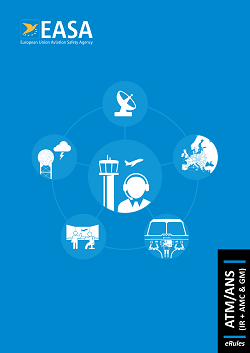Identification of ATS routes other than standard departure and arrival routes
Commission Implementing Regulation (EU) 2020/469
(a) When ATS routes are established, a protected airspace along each ATS route and a safe spacing between adjacent ATS routes shall be provided.
(b) ATS routes shall be identified through designators.
(c) When identifying ATS routes other than standard departure and arrival routes, the designation system used shall:
(1) permit the identification of any ATS route in a simple and unique manner;
(2) avoid redundancy;
(3) be usable by both ground and airborne automation systems;
(4) permit utmost brevity in operational use; and
(5) provide for a sufficient possibility of extension to cater for any future requirements without the need for fundamental changes;
(d) Basic ATS route designators shall be assigned in accordance with the following principles:
(1) the same basic designator shall be assigned to a main trunk route throughout its entire length, irrespective of terminal control areas, States or regions traversed;
(2) where two or more trunk routes have a common segment, the segment in question shall be assigned each of the designators of the routes concerned, except where this would introduce difficulties in the provision of air traffic services (ATS), in which case, by common agreement, one designator only shall be assigned; and
(3) a basic designator assigned to one route shall not be assigned to any other route.
ED Decision 2020/008/R
GENERAL
Controlled, advisory and uncontrolled ATS routes, with the exception of standard arrival and departure routes should be identified as follows:
(a) The basic designator should consist of one letter of the alphabet followed by a number from 1 to 999. The selection of the letter should be made from those listed hereunder:
(1) ‘A’, ‘B’, ‘G’, ‘R’ for routes which form part of the regional networks of ATS routes and are not area navigation routes;
(2) ‘L’, ‘M’, ‘N’, ‘P’ for area navigation routes which form part of the regional networks of ATS routes;
(3) ‘H’, ‘J’, ‘V’, ‘W’ for routes which do not form part of the regional networks of ATS routes and are not area navigation routes; and
(4) ‘Q’, ‘T’, ‘Y’, ‘Z’ for area navigation routes which do not form part of the regional networks of ATS routes.
(b) The ATS route designator should consist of a basic designator supplemented, if necessary, by:
(1) one prefix; where applicable, one supplementary letter may be added as a prefix to the basic designator in accordance with the following:
(i) ‘K’ to indicate a low-level route established for use primarily by helicopters;
(ii) ‘U’ to indicate that the route or portion thereof is established in the upper airspace; and
(iii) ‘S’ to indicate a route established exclusively for use by supersonic aircraft during acceleration, deceleration and while in supersonic flight; and
(2) one additional letter; when prescribed by the competent authority or on the basis of regional air navigation agreements, a supplementary letter may be added after the basic designator of the ATS route in question in order to indicate the type of service provided in accordance with the following:
(i) ‘F’ to indicate that on the route or portion thereof only advisory service is provided; and
(ii) ‘G’ to indicate that on the route or portion thereof only flight information service is provided.
(c) The number of characters required to compose the designator should not exceed six.
(d) The number of characters required to compose the designator should, whenever possible, be kept to a maximum of five.
ED Decision 2020/008/R
GENERAL
(a) Guidance material on the establishment of ATS routes and procedures is contained in ICAO Doc 9426 ‘Air Traffic Services Planning Manual’.
(b) Guidance material on the establishment of ATS routes defined by omni-directional range (VOR) is contained in Attachment A to ICAO Annex 11.
(c) Guidance material on ICAO Codes and Routes Designators (ICARD) is contained in the ICAO Five-Letter Name-Codes (5LNC) Guidelines.
(d) The spacing between parallel tracks or between parallel ATS route centre lines based on performance-based navigation should be dependent upon the relevant navigation specification required.
(e) When warranted by density, complexity or nature of the traffic, special routes should be established for use by low-level traffic, including helicopters operating to and from helidecks on the high seas. When determining the horizontal spacing between such routes, account should be taken of the navigational means available and the navigation equipment carried on helicopters’ board.
